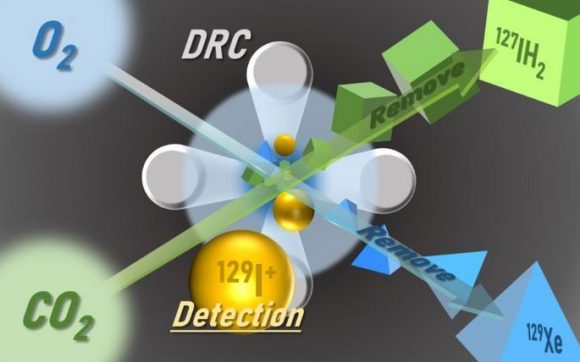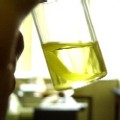松枝誠さん(博士後期課程3年)の研究成果が、2022年11月号のSpringer「Analytical Sciences」誌に論文が掲載されました。
また,2023年11月号のHot Article(注目論文)に選ばれました。
【著者/論文誌名】M. Matsueda, J. Aoki, K. Koarai, M. Terashima, Y. Takagai*, Analytical Sciences, 38, 1371-1376 (2022).
【DOI】https://doi.org/10.1007/s44211-022-00180-w
【概要】放射性のヨウ素129(¹²⁹I)は、半減期が約1600万年と非常に長い人工の放射性核種です。その一方で、原子力災害(例えば、原子力発電所事故や隣国の核実験)で放出され、甲状腺ガンを誘発する放射性ヨウ素131(¹³¹I)の半減期はわずか8日しかありません。そのため、災害や事故の原因を究明したり、環境にどのように飛散したかを数年後に追跡調査することは極めて難しいです。その問題を回避するため,半減期の短い¹³¹Iの代わりに半減期の長い¹²⁹Iが測定できれば、事故時の当時の状況や現在の環境への負荷の状況が分かります。しかし、環境中の¹²⁹Iの存在濃度は非常に低いので、これを分析するためには100リットル近くの試料水を濃縮して,分析機器で計測できる濃度範囲まで濃度を濃くする必要があります。
ところが,濃縮を行うと、分析ターゲットの¹²⁹Iだけでなく、元々環境にある(放射線を出さない)安定同位体の¹²⁷Iも同じヨウ素で化学的性質が一緒(=同じ元素)なので,一緒に濃縮されてしまいます。つまり、大量の¹²⁷Iの中に、ごくわずかなの¹²⁹Iがほんの少しあるという状況になります。このような状況を「¹²⁹I/¹²⁷I比が低い」と呼びます。
その一方で,誘導結合プラズマタンデム型質量分析計(ICP-MS/MS)で¹²⁹Iを測定すると、測定を妨害する核種が多く、さらには、ピークテーリングという現象があり(=m/z 127のイオンが大量にありすぎて, m/z 129にまで影響を及ぼして何を分析しているのか訳が分からなくなる現象のこと)、低い¹²⁹I/¹²⁷I比を計測することは困難でした。
今回,ICP-MS/MS分析装置のリアクションセルと呼ぶ機構に酸素と二酸化炭素の混合ガスを導入すると、非常に低い¹²⁹I/¹²⁷I比まで計測できることを発見しました。市販のICP-MS/MSでここまで非常に低い¹²⁹I/¹²⁷I比を計測できることはほとんどなく,これが評価されて論文掲載に至ったというものです。
This paper presents a mass-spectrometric method for determining the radionuclide iodine-129 (129I) from the significant amount of interference in inductively coupled plasma tandem quadrupole mass spectrometry (ICP–MS/MS) using a dynamic reaction cell passing a mixture gas of O2 and CO2. Thus far, mass spectrometry analysis of trace amounts of 129I has been hampered by the presence of xenon-129 (129Xe) and the formation of polyatomic ions from excess amounts of stable isotope 127I. In this study, flowing a mixture gas of O2 and CO2 into the dynamic reaction cell (Q2) successfully removed both 129Xe interference and polyatomic interference (127IH2) in the analysis of 129I in ICP–MS/MS. The resulting ratio of (background noise of m/z 129)/127I was 4.6 × 10–10 ± 3.3 × 10–10, which enables the analysis of 10 mBq/L of 129I in the presence of 100 mg/L of stable 127I without chemical separation. The detection limit of this method was 0.73 mBq/L (= 0.11 ng/L) with an APEX-Q sample inlet desolvation device. For demonstration purposes, spike and recovery analysis of rainwater was performed, and good agreement between the spiked and recovered amounts was achieved.

 私たちの研究室では、環境や生体中に存在する超微量成分を分析(分離・定量)するための新しい分析システムを開発しています。その開発の過程で,新しい化学現象を発見することもしばしばあり,その化学現象の解明にも勤しんでいます。
私たちの研究室では、環境や生体中に存在する超微量成分を分析(分離・定量)するための新しい分析システムを開発しています。その開発の過程で,新しい化学現象を発見することもしばしばあり,その化学現象の解明にも勤しんでいます。